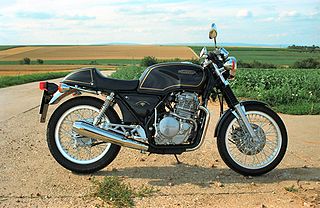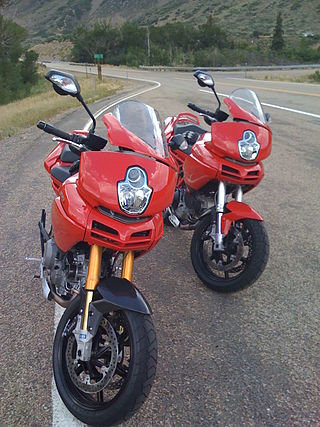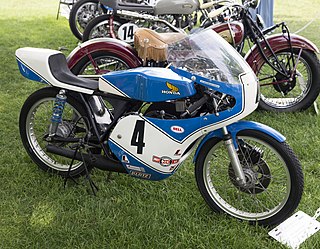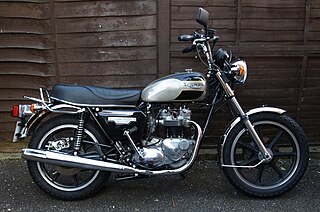
The Chevrolet Impala is a full-size car that was built by Chevrolet for model years 1958 to 1985, 1994 to 1996, and 2000 to 2020. The Impala was Chevrolet's popular flagship passenger car and was among the better-selling American-made automobiles in the United States.

The Honda Magna is a cruiser motorcycle made from 1982 to 1988 and 1994 to 2003 and was the second Honda to use their new V4 engine shared with the VF750S Sabre and a few years later a related engine was fitted to the VF750F 'Interceptor', the later models used a retuned engine from the VFR750F with fins added to the outside of the engine. The engine technology and layout was a descendant of Honda's racing V4 machines, such as the NS750 and NR750. The introduction of this engine on the Magna and the Sabre in 1982, was a milestone in the evolution of motorcycles that would culminate in 1983 with the introduction of the Interceptor V4. The V45's performance is comparable to that of Valkyries and Honda's 1800 cc V-twin cruisers. However, its mix of performance, reliability, and refinement was overshadowed by the more powerful 1,098 cc "V65" Magna in 1983.

The Honda Shadow refers to a family of cruiser-type motorcycles made by Honda since 1983. The Shadow line features motorcycles with a liquid-cooled 45 or 52-degree V-twin engine ranging from 125 to 1,100 cc engine displacement. The 250 cc Honda Rebel is associated with the Shadow line in certain markets.

The Honda Gold Wing is a series of touring motorcycles manufactured by Honda. Gold Wings feature shaft drive and a flat engine. Characterized by press in September 1974 as "The world's biggest motor cycle manufacturer's first attack on the over-750cc capacity market...", it was introduced at the Cologne Motorcycle Show in October 1974.

The Honda CX series motorcycles, including the GL500 and GL650 Silver Wing variants, were developed and released by Honda in the late 1970s, with production ending in most markets by the mid 1980s. The design included innovative features and technologies that were uncommon or unused at the time such as liquid cooling, electric-only starting, low-maintenance shaft drive, modular wheels, and dual CV-type carburetors that were tuned for reduced emissions. The electronic ignition system was separate from the rest of the electrical system, but the motorcycle could only be started via the start button.
The Honda VT series comprises motorbikes with two-cylinder V engines. More sporting V engined bikes are given "VTR" model numbers. Four-cylinder V-engined Hondas are designated VF or VFRs, while Honda motorbikes with inline engines mostly belong to the CB and CBR series.

The Honda GB500 'Tourist Trophy' is an air-cooled single-cylinder solo café racer motorcycle. It was first marketed in Japan in 1985 in two 400 cc and one 500 cc versions. In 1989, Honda introduced a third 400 cc version for Japan; and in 1989 and 1990 a 500 cc version was available in the United States.

First introduced in 2003, the Ducati Multistrada is a series of V-twin and V4 touring focused motorcycles. Essentially a hybrid of a supermoto and a sport-tourer, the Multistrada competes in the market with other dual-sport motorcycles such as the BMW GS. The first iteration of the Multistrada was, like the Yamaha TDM850, neither intended nor suitable for off-road use. Subsequent models were more suited to a proper dual-sport role.

The Hero Honda Splendor is an entry level motorcycle manufactured in India by Hero Honda. After Separation of Joint venture of Hero Honda, Now it is manufactured by Hero MotoCorp. It has an electronic ignition and a tubular double cradle type frame with a 97.2 cc (5.93 cu in) engine. The engine is based on the Honda Cub C100EX with a similar bore and stroke of 50 mm × 49.5 mm. As of 2009, Splendor models were selling at a rate of one million units per year.

The Harley-Davidson Sportster is a line of motorcycles produced continuously since 1957 by Harley-Davidson. Sportster models are designated in Harley-Davidson's product code by beginning with "XL". In 1952, the predecessors to the Sportster, the Model K Sport and Sport Solo motorcycles, were introduced. These models K, KK, KH, and KHK of 1952 to 1956 had a sidevalve engine, whereas the later XL Sportster models use an overhead valve engine. The first Sportster in 1957 had many of the same features of the KH including the frame, fenders, large gas tank and front suspension.

The Triumph Bonneville is a standard motorcycle featuring a parallel-twin four-stroke engine and manufactured in three generations over three separate production runs.
The Honda CT series was a group of Honda trail bike motorcycles made since 1964. The CT designation is a slight exception in Honda nomenclature in that "CT" does not indicate a series of mechanically related bikes, but rather a group of different bikes that are all for casual off-road use.
The Ducati SportClassics are a range of retro styled motorcycles introduced by Ducati at the 2003 Tokyo Motor Show, and put on sale in 2005 for the 2006 model year. The Paul Smart version was made for the 2006 model year only, while the Sport1000 ran from 2006 through the 2009 model years, and the GT1000 ran from the 2007 through 2010 model years.

The Ducati Supersport and SS are a series of air-cooled four stroke desmodromic 2-valve 90° L-twin motorcycles made by Ducati since 1988. A limited edition Supersport called the SuperLight was sold in 1992. The name harked back to the round case 1973 Ducati 750 Super Sport, and the 1975 square case 750 and 900 Super Sport. The appellation 'SS' was applied only to the later belt drive (Pantah) based models.

The Honda Ascot is a name given to two motorcycles produced by Honda in the early 1980s. The motorcycles, the FT500 and VT500FT, were produced with the Ascot name between 1982 and 1984.

The Honda MT125R was a production Grand Prix motorcycle racing roadracer designed for closed-course competition roadracing. It was produced by Honda Racing Service Center (RSC) and made available to the general public. It was also marketed for the U.S. market in the years 1977–1978 through the American Honda Motorcycle dealer network and in Canada through Canadian Honda Motors Ltd.,

The Triumph Bonneville T140 is a standard motorcycle with a 750 cc (46 cu in) capacity engine that was designed and built by Triumph Engineering at Meriden near Coventry.

The Kawasaki A1 Samurai is a 250 cc (15 cu in) standard class Kawasaki motorcycle which was sold from 1967 through 1971.

The Jeep Wrangler YJ is the first generation of Jeep Wrangler four-wheel drive small off-road vehicles, rebadging and succeeding Jeep's CJ series, which was produced from 1944 to 1986. The first Wrangler was launched in 1986 and ran through 1995. Although the new Wrangler stood out from its CJ predecessors by its square headlights, its body was a direct evolution of the preceding CJ-7, and rode on the same wheelbase. The Wrangler featured an updated interior, offered more comfort and improved safety and handling, through a revised chassis that included a wider track and a slightly lower stance.

The Jeep Wrangler (TJ) is the second generation of the Jeep Wrangler off-road and sport utility vehicle. Introduced in 1996 as a 1997 model, the TJ reintroduced the circular headlights the classic Jeep models had been known for. For the 2004 model year, the long-wheelbase Unlimited model was introduced.


















